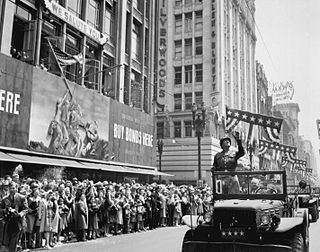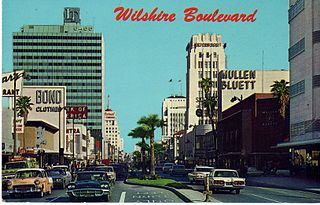
Miracle Mile is a neighborhood in the city of Los Angeles, California.

Gilbert Stanley Underwood was an American architect best known for his National Park lodges.
Ohrbach's was a moderate-priced department store with a merchandising focus primarily on clothing and accessories. From its modest start in 1923 until the chain's demise in 1987, Ohrbach's expanded dramatically after World War II, and opened numerous branch locations in the New York and Los Angeles metropolitan areas. Its original flagship store was located on Union Square in New York City. It maintained administrative offices in Newark and in Los Angeles. The retailer closed the Newark offices in the 1970s. Paul László designed the Union Square store as well as many of their other stores.

Wilshire Boulevard (['wɪɫ.ʃɚ]) is a prominent 15.83 mi (25.48 km) boulevard in the Los Angeles area of Southern California, extending from Ocean Avenue in the city of Santa Monica east to Grand Avenue in the Financial District of downtown Los Angeles. One of the principal east–west arterial roads of Los Angeles, it is also one of the major city streets through the city of Beverly Hills. Wilshire Boulevard runs roughly parallel to Santa Monica Boulevard from Santa Monica to the west boundary of Beverly Hills. From the east boundary, it runs a block south of Sixth Street to its terminus.

Stiles Oliver Clements was an architect practicing in Los Angeles and Southern California.

Museum Square or the SAG-AFTRA Building, originally the Prudential Building is a landmark building at 5757–5779 Wilshire Boulevard, spanning two city blocks along that street, on the Miracle Mile, Los Angeles housing SAG-AFTRA. It was opened in 1949 and was the tallest and, at 517,000 sq ft (48,000 m2), the largest privately owned structure in Los Angeles at that time. Welton Beckett of Wurdeman & Becket was the architect who designed it in the International Style. The building was part of the decentralization program by Prudential (1948-1965), with Rubin arguing that it included a "deliberate" urban-shaping policy: dazzling office buildings with large parking lots were constructed at the edges of established business districts.
Claud W. Beelman, sometimes known as Claude Beelman, was an American architect who designed many examples of Beaux-Arts, Art Deco, and Streamline Moderne style buildings. Many of his buildings are listed on the National Register of Historic Places.

Johnie's Coffee Shop is a former coffee shop and a well-known example of Googie architecture located on the corner of Wilshire Boulevard and Fairfax Avenue in Los Angeles, California. Architects Louis Armét and Eldon Davis of Armét & Davis designed the building, contributing to their reputation as the premier designers of Space Age or Googie coffee shops—including the landmark Pann's coffee shop in Ladera Heights, Norms Restaurant on La Cienega Boulevard, and several Bob's Big Boy restaurants.

Morgan, Walls & Clements was an architectural firm based in Los Angeles, California and responsible for many of the city's landmarks, dating back to the late 19th century. Originally Morgan and Walls, with principals Octavius Morgan and John A. Walls, the firm worked in the area from before the turn of the century.

The Saban Building, formerly the May Company Building, on Wilshire Boulevard in the Miracle Mile district of Los Angeles, is a celebrated example of Streamline Moderne architecture. The building's architect Albert C. Martin, Sr., also designed the Million Dollar Theater and Los Angeles City Hall. The May Company Building is a Los Angeles Historic-Cultural Monument. The building was operated as a May Company department store from 1939 until the store's closure in 1992, when May merged with J. W. Robinson's to form Robinsons-May. The building has been the home of the Academy Museum of Motion Pictures since 2021.

William Douglas Lee was an American architect and designer in the early 20th century whose career focused on designing large Neoclassic, Gothic Revival, Renaissance Revival, and Beaux-Arts style manufacturing buildings in Downtown Los Angeles, as well as other historically notable works such as the Chateau Marmont and the El Royale apartments.
Douglas Honnold was an award-winning Canadian-born American architect. He designed many residential properties and commercial buildings in Los Angeles, California. He won an Honor Award from the Southern California Chapter of the American Institute of Architects in January 1947 for his design of the Embassy Shop in Beverly Hills alongside architect John Lautner. He turned down the offer to design the famous McDonald's golden arches.
Mandel's was a chain of shoe stores in the Southwestern United States for many decades of the 20th century. For a time it advertised its wares as "Mandel's Fascinating Slippers". Maurice Mandel headed up the stores through the 1930s, 1940s and 1950s. Later Mandel would later serve as General Merchandise Manager (GMM) of chain Mullen & Bluett and president of Harris & Frank. Among its branches were:

Coulter's was a department store that originated in Downtown Los Angeles and later moved to the Miracle Mile shopping district in that same city.

Mullen & Bluett was a Los Angeles-based department store specializing in men's clothing.

Phelps-Terkel was a Los Angeles based department store specializing in men's clothing.

Myer Siegel was a Los Angeles–based department store, founded by Myer Siegel (1866–1934), specializing in women's clothing.

7th Street is a street in Los Angeles, California running from S. Norton Ave in Mid-Wilshire through Downtown Los Angeles. It goes all the way to the eastern city limits at Indiana Ave., and the border between Boyle Heights, Los Angeles and East Los Angeles.

9600 Wilshire Boulevard is a building located within the Golden Triangle business district of Beverly Hills, California. It housed a Saks Fifth Avenue department store from its completion in 1938, and was considered a second flagship store by the company, after the flagship store in New York City. The store relocated to the adjacent 9570 Wilshire Boulevard in 2024, and the original location will be converted into a mixed-use development by Hudson's Bay Company.

Retail in Southern California dates back to its first dry goods store that Jonathan Temple opened in 1827 on Calle Principal, when Los Angeles was still a Mexican village. After the American conquest, as the pueblo grew into a small town surpassing 4,000 population in 1860, dry goods stores continued to open, including the forerunners of what would be local chains. Larger retailers moved progressively further south to the 1880s-1890s Central Business District, which was later razed to become the Civic Center. Starting in the mid-1890s, major stores moved ever southward, first onto Broadway around 3rd, then starting in 1905 to Broadway between 4th and 9th, then starting in 1915 westward onto West Seventh Street up to Figueroa. For half a century Broadway and Seventh streets together formed one of America's largest and busiest downtown shopping districts.

















